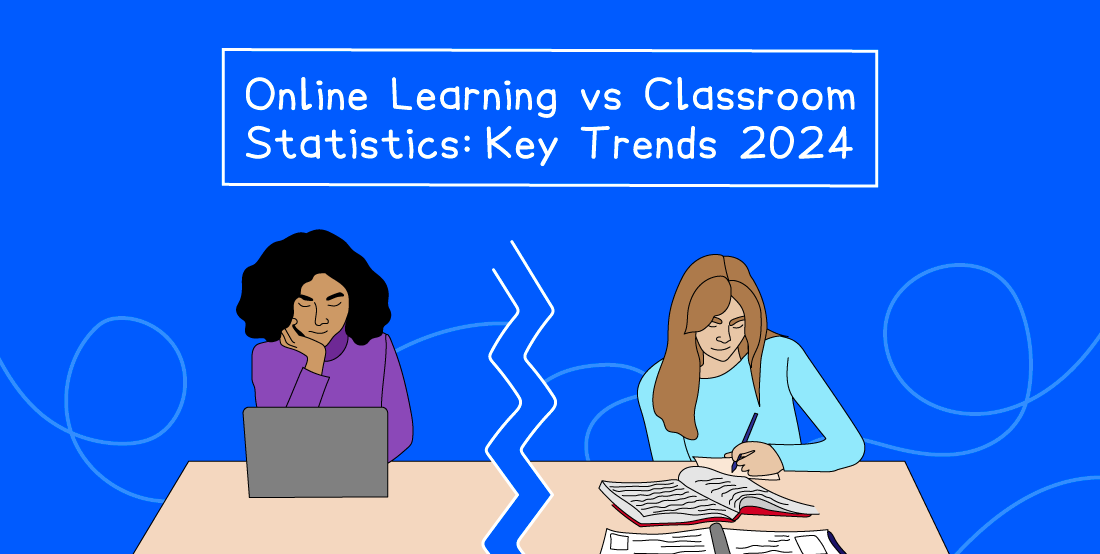Contents
The rise of online learning has transformed the educational landscape, making it easier than ever to learn from the comfort of your home.
But now, students are starting to see that online learning has its own challenges. Has the lack of a physical teacher and in-person interaction lost some of its initial appeal? If, like me, you experienced the shift to fully online teaching during the pandemic, and wondered if it was the end of traditional classrooms, it's time to reconsider.
In this article, we’ll explore the top 10 online learning statistics shaping the debate between online learning and in-person classes in 2024.
10 Online Learning Statistics
54% of students preferred classroom-based learning for better focus and interaction, while 47% favoured online learning for its flexibility and time-saving benefits
64% of respondents believe schools should focus on in-person learning rather than offering an online format
55% of adult undergraduates prefer a hybrid model that combines online and in-person classes
70% of learners are more motivated to learn when they use mobile devices instead of computers
Gamification can boost learner engagement by up to 60%
E-learning can help students retain between 25% and 60% more information
98% of universities have shifted their classes online since 2020
The global e-learning market is projected to reach $457.8 billion by 2026
E-learning is the quickest-growing market in the education sector, with a whopping 900% growth rate since 2000
99% of organisations provide e-learning to their employees, in contrast to just 76% only 5 years ago
What Does the Research Say?
54% of students preferred classroom-based learning for better focus and interaction, while 46.5% favoured online learning for its flexibility and time-saving benefits
A 2024 study revealed that over half of students still prefer learning in a traditional classroom setting. It seems that the challenges of staying focused in a digital environment, amidst constant distractions, have become a significant hurdle. However, online learning has its appeal – 47% of students appreciate the flexibility it offers, allowing them to study whenever it fits into their schedule.
Source: VdoCipher
64% of respondents did not support the idea of schools being exclusively online, indicating a preference for traditional classroom settings
This is encouraging news for teachers, as it shows a continued demand for the presence of educators in the classroom. Many students recognise the value of having a dedicated teacher who can guide their learning, rather than relying solely on the refinement of online platforms.
Source: MDPI
55% of adult undergraduates prefer a hybrid model that combines online and in-person classes
As we grow older, our ability to self-regulate and manage distractions during online learning seems to improve. This shift might explain why more than half of adult undergraduates are drawn to the hybrid approach – it offers the best of both worlds. With the flexibility and time-saving benefits of online courses, alongside the structure and support of in-person learning, this model seems to meet the evolving needs of adult learners.
Source: Encoura
70% of learners are more motivated to learn when they use mobile devices instead of computers
It’s hardly surprising – many of us spend more time on our phones than on computers in 2024. In my nearly 20 years of classroom experience, I’ve witnessed the rise of mobile devices and the ongoing debate in education: should we ban them or embrace them? Learners are showing greater motivation when using mobile devices, it’s clear that we can't ignore their impact. A traditional classroom-based approach doesn’t have to exclude mobile technology. How we fully integrate these tools is a question for another article.
Source: Sciedu
Gamification can boost learner engagement by up to 60%
Throughout my career as a Computer Science teacher, I’ve seen first-hand how gamification can transform the classroom experience. By offering learners clear goals, a sense of purpose, and a chance to compete with friends, gamification makes learning both fun and effective. It’s no surprise that some of my most enjoyable lessons involved elements of gamification; the atmosphere of engagement – and sometimes even excitement – was palpable. However, the key to its success often lies in how well it is managed and integrated into the learning process.
Source: Psico-smart
E-learning can help students retain between 25% and 60% more information
In situations where practice makes perfect, this approach can be a game changer. When students forget what the teacher says, online learning allows them to revisit the material as many times as needed until they truly grasp it. This repeated exposure is crucial for retention, and it’s no surprise that students who can retain information tend to perform better in exams. E-learning isn’t a replacement for traditional teaching, but it’s a powerful tool that can enhance the learning experience.
Source: eLearning Industry
98% of universities have shifted their classes online since 2020
The pandemic compelled many institutions to adapt, and this statistic reflects that shift. However, it can be somewhat misleading; it doesn’t imply that universities have abandoned traditional classroom-based learning. Rather, it indicates that they now provide online options alongside their in-person offerings. This trend serves as clear evidence that online learning is here to stay, adapting to the evolving needs of students and educators alike.
Source: Admissionsly
The global e-learning market is projected to reach $457.8 billion by 2026
When compared to other industries - such as digital health ($657 billion), online gaming ($320 billion), and digital advertising ($600 billion) - it’s clear that e-learning is emerging as a significant player. This rapid expansion can be attributed to several factors, including the rise of remote work, the increasing demand for upskilling, and broader internet access. As these trends continue, e-learning is poised to further establish itself in the global marketplace.
Source: GlobeNewswire
E-learning is the quickest-growing market in the education sector with a whopping 900% growth rate since 2000
It has revolutionised the way learners engage with education, allowing them to study anywhere and anytime. From individuals pursuing degrees to those learning for personal enjoyment, the possibilities are endless, contributing significantly to the sector's rapid expansion. The pandemic accelerated the development of e-learning by years, highlighting that learners crave options - and e-learning is a viable choice for everyone.
Source: Oxford College
99% of organisations provide e-learning to their employees, in contrast to just 76% only 5 years ago
When discussing online learning versus classroom-based learning, we often focus on schools and universities, overlooking the significant impact on organisations. So, what has driven this rapid adoption? Have companies recognised the benefits of flexibility and time-saving for their employees, or are they looking to reduce costs? This debate could certainly continue, but one thing is clear: e-learning is becoming a standard practice in the workplace, and it’s here to stay.
Source: Emerald Insight
Key Online Learning Themes and Trends 2024
The majority of students prefer classroom-based learning
It may come as a surprise to learn that the majority of students surveyed actually prefer classroom-based learning. For those who have been away from education for some time, it’s easy to assume that students in 2024 would naturally gravitate toward the obvious benefits of online learning.
The initial excitement of studying independently – like the freedom to study at 2 AM – has started to fade. Students are coming to appreciate the value of having a teacher in the room, providing consistency, experience, support, and, above all, structure. However, online learning also plays an important role, offering flexibility and additional resources that can complement the structured guidance of a teacher. Together, both approaches create a more well-rounded learning experience.
We want the best of both worlds
At Save My Exams, we recognise the importance of having the best of both online and classroom-based learning. Students value the presence of an expert in the room – someone with the experience and skill to tailor lessons to meet the diverse needs of learners. At the same time, we seek the flexibility to study when it fits our busy schedules, without compromising the work-life balance we strive to achieve.
Conclusion
There is undoubtedly a place for both online and classroom-based learning in 2024, and this trend is likely to continue. The growth and expansion of the e-learning sector worldwide highlight its necessity. However, we must not overlook the educators on the ground – teachers, tutors, and lecturers – who provide stability and a foundation that empowers learners to push themselves and strive for excellence.
References
Here at Save My Exams, we develop high-quality, affordable revision resources; consider signing up for a Save my Exams subscription to help you get the most out of your revision. We support over 1.5 million students each month in preparing for their exams and achieving successful results, we’d love to help you too.
Sign up for articles sent directly to your inbox
Receive news, articles and guides directly from our team of experts.

Share this article


 written revision resources that improve your
written revision resources that improve your